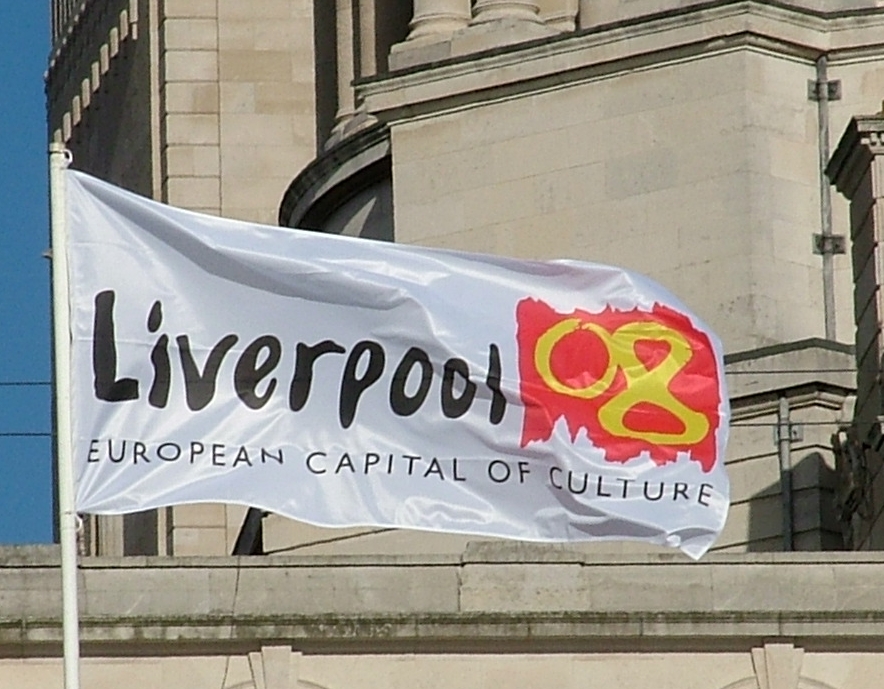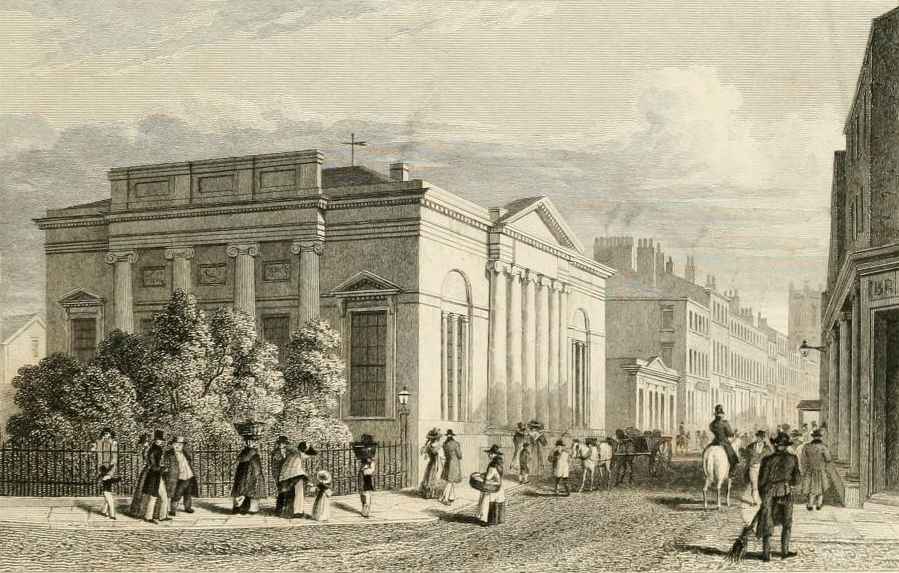|
Liverpool Central Library
Liverpool Central Library is the largest of the 22 libraries in Liverpool, England, situated in the centre of the city. History The library is located in several adjoining historic buildings on William Brown Street. Its first building was the William Brown Library and Museum building which was completed in 1860 to the designs of John Weightman Surveyor to Liverpool Corporation, (not to be confused with his near contemporary John Grey Weightman) and which it has always shared with the city's museum, now known as World Museum Liverpool. The library was then extended further to the right with the addition in 1879 of the Picton Reading Room and to the rear with the Hornby Library in 1906. All three of these are Grade II* listed buildings and are built in a classical style similar to other buildings on the street. Previous to the creation of this public library was England's first subscription library (1758-1942), latterly known as The Lyceum, Liverpool, but often referred to a ... [...More Info...] [...Related Items...] OR: [Wikipedia] [Google] [Baidu] |
Liverpool
Liverpool is a city and metropolitan borough in Merseyside, England. With a population of in 2019, it is the 10th largest English district by population and its metropolitan area is the fifth largest in the United Kingdom, with a population of 2.24 million. On the eastern side of the Mersey Estuary, Liverpool historically lay within the ancient hundred of West Derby in the county of Lancashire. It became a borough in 1207, a city in 1880, and a county borough independent of the newly-created Lancashire County Council in 1889. Its growth as a major port was paralleled by the expansion of the city throughout the Industrial Revolution. Along with general cargo, freight, and raw materials such as coal and cotton, merchants were involved in the slave trade. In the 19th century, Liverpool was a major port of departure for English and Irish emigrants to North America. It was also home to both the Cunard and White Star Lines, and was the port of registry of the ocean lin ... [...More Info...] [...Related Items...] OR: [Wikipedia] [Google] [Baidu] |
Public Library
A public library is a library that is accessible by the general public and is usually funded from public sources, such as taxes. It is operated by librarians and library paraprofessionals, who are also civil servants. There are five fundamental characteristics shared by public libraries: they are generally supported by taxes (usually local, though any level of government can and may contribute); they are governed by a board to serve the public interest; they are open to all, and every community member can access the collection; they are entirely voluntary, no one is ever forced to use the services provided and they provide library and information services services without charge. Public libraries exist in many countries across the world and are often considered an essential part of having an educated and literate population. Public libraries are distinct from research libraries, school libraries, academic libraries and other special libraries. Their mandate is to serve the ... [...More Info...] [...Related Items...] OR: [Wikipedia] [Google] [Baidu] |
Grade II* Listed Buildings In Liverpool
Grade most commonly refers to: * Grade (education), a measurement of a student's performance * Grade, the number of the year a student has reached in a given educational stage * Grade (slope), the steepness of a slope Grade or grading may also refer to: Music * Grade (music), a formally assessed level of profiency in a musical instrument * Grade (band), punk rock band * Grades (producer), British electronic dance music producer and DJ Science and technology Biology and medicine * Grading (tumors), a measure of the aggressiveness of a tumor in medicine * The Grading of Recommendations Assessment, Development and Evaluation (GRADE) approach * Evolutionary grade, a paraphyletic group of organisms Geology * Graded bedding, a description of the variation in grain size through a bed in a sedimentary rock * Metamorphic grade, an indicatation of the degree of metamorphism of rocks * Ore grade, a measure that describes the concentration of a valuable natural material in the surr ... [...More Info...] [...Related Items...] OR: [Wikipedia] [Google] [Baidu] |
Culture In Liverpool
The culture of Liverpool incorporates a wide range of activities within the city of Liverpool, England. The city is an important centre for culture not just in the northwest of England, but also the United Kingdom more broadly. Its contributions to culture internationally were recognised in 2008, when it was named the European Capital of Culture. Capital of Culture On 4 June 2008, Liverpool was named a European Capital of Culture for 2008, the other site being Stavanger, Norway. Literature Beryl Bainbridge, one of England's greatest contemporary writers, grew up in Liverpool. Many of her stories are set there. A number of notable authors have visited Liverpool including Daniel Defoe, Washington Irving, Thomas De Quincey, Herman Melville, Nathaniel Hawthorne, Charles Dickens, Gerard Manley Hopkins and Hugh Walpole all of whom spent extended periods in the city. Hawthorne was stationed in Liverpool as United States consul between 1853 and 1856. Although he is not known ... [...More Info...] [...Related Items...] OR: [Wikipedia] [Google] [Baidu] |
Public Libraries In Merseyside
In public relations and communication science, publics are groups of individual people, and the public (a.k.a. the general public) is the totality of such groupings. This is a different concept to the sociological concept of the ''Öffentlichkeit'' or public sphere. The concept of a public has also been defined in political science, psychology, marketing, and advertising. In public relations and communication science, it is one of the more ambiguous concepts in the field. Although it has definitions in the theory of the field that have been formulated from the early 20th century onwards, and suffered more recent years from being blurred, as a result of conflation of the idea of a public with the notions of audience, market segment, community, constituency, and stakeholder. Etymology and definitions The name "public" originates with the Latin '' publicus'' (also '' poplicus''), from '' populus'', to the English word ' populace', and in general denotes some mass population ("the ... [...More Info...] [...Related Items...] OR: [Wikipedia] [Google] [Baidu] |
Roof Terrace
A terrace is an external, raised, open, flat area in either a landscape (such as a park or garden) near a building, or as a roof terrace on a flat roof. Ground terraces Terraces are used primarily for leisure activity such as sitting, strolling, or resting.Davies, Nicholas and Jokiniemi, Erkki. ''Dictionary of Architecture and Building Construction''. New York: Routledge, 2008, p. 379. The term often applies to a raised area in front of a monumental building or structure, which is usually reached by a grand staircase and surrounded by a balustrade. A terrace may be supported by an embankment or solid foundation, either natural or man-made.Harris, Cyril M. ''Illustrated Dictionary of Historic Architecture''. New York: Dover Publications, 1977, p. 529. Terraces may also be platforms, supported by columns but without the space below filled in, but terraces are always open to the sky and may or may not be paved.Ching, Frank. ''A Visual Dictionary of Architecture''. Hoboken, N.J.: ... [...More Info...] [...Related Items...] OR: [Wikipedia] [Google] [Baidu] |
Atrium (architecture)
In architecture, an atrium (plural: atria or atriums) is a large open-air or skylight-covered space surrounded by a building. Atria were a common feature in Ancient Roman dwellings, providing light and ventilation to the interior. Modern atria, as developed in the late 19th and 20th centuries, are often several stories high, with a glazed roof or large windows, and often located immediately beyond a building's main entrance doors (in the lobby). Atria are a popular design feature because they give their buildings a "feeling of space and light." The atrium has become a key feature of many buildings in recent years. Atria are popular with building users, building designers and building developers. Users like atria because they create a dynamic and stimulating interior that provides shelter from the external environment while maintaining a visual link with that environment. Designers enjoy the opportunity to create new types of spaces in buildings, and developers see atria as ... [...More Info...] [...Related Items...] OR: [Wikipedia] [Google] [Baidu] |
Liverpool World Museum
World Museum is a large museum in Liverpool, England which has extensive collections covering archaeology, ethnology and the natural and physical sciences. Special attractions include the Natural History Centre and a planetarium. Entry to the museum is free. The museum is part of National Museums Liverpool. History The museum was originally started as the Derby Museum as it comprised the 13th Earl of Derby's natural history collection. It opened in 1851, sharing two rooms on Duke Street with a library. However, the museum proved extremely popular and a new, purpose-built building was required. Land for the new building, on a street then known as Shaw's Brow (now William Brown Street), opposite St George's Hall, was donated by local MP and Merchant William Brown, as was much of the funding for the building which would be known as the William Brown Library and Museum. Around 400,000 people attended the opening of the new building in 1860. Reports detailing the museum's ... [...More Info...] [...Related Items...] OR: [Wikipedia] [Google] [Baidu] |
The Lyceum, Liverpool
The Lyceum is a Neoclassical Grade II* listed building located on Bold Street, Liverpool. It was constructed in 1802 as a news-room and England's first subscription library (1758–1942) and later became a gentleman's club. After the club relocated in 1952 the building was left unoccupied for many years, eventually falling into a state of disrepair. Calls were made for its demolition in the late 1970s, sparking a campaign to save the building. It reopened as a post office, and then a branch of the Co-operative Bank. As of November 2019, its tenant is a Chinese restaurant. Construction In 1757 members of a small literary club met in the house of William Everard, a teacher, to discuss reviews, periodicals and later books, which they circulated amongst themselves. On 1 May 1758 the Liverpool Library was established and the books which were originally stored in a large chest in Everard's parlor were moved to a number of different premises around the city centre as the collectio ... [...More Info...] [...Related Items...] OR: [Wikipedia] [Google] [Baidu] |
Subscription Library
A subscription library (also membership library or independent library) is a library that is financed by private funds either from membership fees or endowments. Unlike a public library, access is often restricted to members, but access rights can also be given to non-members, such as students. Origins In the 18th century, there were virtually no public libraries in the sense in which we now understand the term i.e. libraries provided from public funds and freely accessible to all.Kelly, Thomas (1966); p. 185 Only one important library in Britain, Chetham's Library in Manchester, was fully and freely accessible to the public. However, during the century, there came into being a whole network of library provision on a private or institutional basis. The increase in secular literature at this time encouraged the establishment of commercial subscription libraries. Many small, private book clubs evolved into subscription libraries, charging high annual fees or requiring subscribin ... [...More Info...] [...Related Items...] OR: [Wikipedia] [Google] [Baidu] |
Liverpool Central Library 1
Liverpool is a City status in the United Kingdom, city and metropolitan borough in Merseyside, England. With a population of in 2019, it is the List of English districts by population, 10th largest English district by population and its ESPON metropolitan areas in the United Kingdom, metropolitan area is the fifth largest in the United Kingdom, with a population of 2.24 million. On the eastern side of the Mersey Estuary, Liverpool historically lay within the ancient Hundred (county division), hundred of West Derby (hundred), West Derby in the county of Lancashire. It became a Borough status in the United Kingdom, borough in 1207, a City status in the United Kingdom, city in 1880, and a county borough independent of the newly-created Lancashire County Council in 1889. Its Port of Liverpool, growth as a major port was paralleled by the expansion of the city throughout the Industrial Revolution. Along with general cargo, freight, and raw materials such as coal and cotton ... [...More Info...] [...Related Items...] OR: [Wikipedia] [Google] [Baidu] |
England
England is a country that is part of the United Kingdom. It shares land borders with Wales to its west and Scotland to its north. The Irish Sea lies northwest and the Celtic Sea to the southwest. It is separated from continental Europe by the North Sea to the east and the English Channel to the south. The country covers five-eighths of the island of Great Britain, which lies in the North Atlantic, and includes over 100 smaller islands, such as the Isles of Scilly and the Isle of Wight. The area now called England was first inhabited by modern humans during the Upper Paleolithic period, but takes its name from the Angles, a Germanic tribe deriving its name from the Anglia peninsula, who settled during the 5th and 6th centuries. England became a unified state in the 10th century and has had a significant cultural and legal impact on the wider world since the Age of Discovery, which began during the 15th century. The English language, the Anglican Church, and Engli ... [...More Info...] [...Related Items...] OR: [Wikipedia] [Google] [Baidu] |











